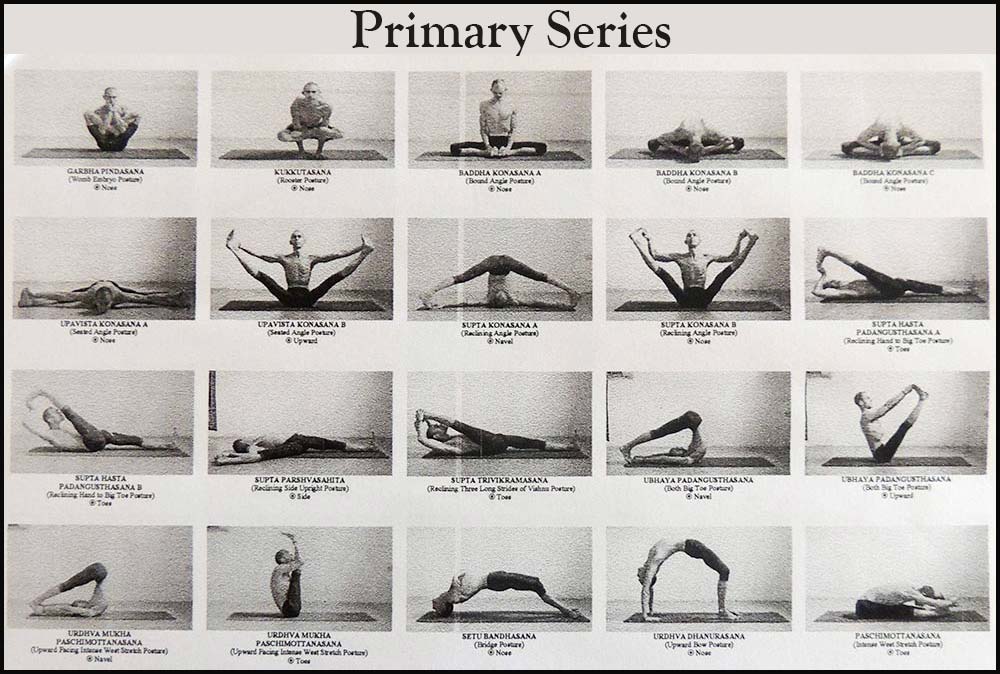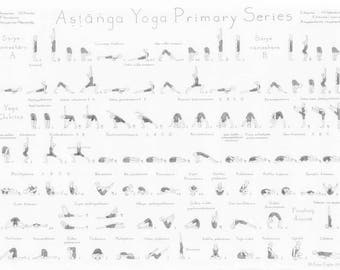Ashtanga Yoga The Primary Series

Can you get an anatomical imbalance from yoga practice? Ashtanga – The Methodology Behind the Postures: Part 2 I recently received a good question from Kara. She asks, “ Hi David, I have a question about your opinion on primary series. In your opinion, is it bad for the body to practice just primary series for an extended period of time (more than a few years)?
I have been practicing Ashtanga Yoga for about 2 years now and bought this DVD cause I really couldn't afford to pay $20 every time I wanted to take a class. Ashtanga yoga asanas names and sequences. List and meaning of yoga poses of primary series of the Ashtanga Yoga. Jul 02, 2017 Practice with the Full Course HERE: Kino MacGregor’s Ashtanga Yoga Primary Series course is a comprehensive practice.
I know all bodies and circumstances vary, but was wondering anatomically what your thoughts on this were. Thanks!” The simple answer is that there is a point, anatomically speaking, that doing the same postures over and over again, such as, can create an overall imbalance in structures and tissues.
As you point out, bodies and circumstances vary, and consequently, the point at which doing the same movements creates an anatomical imbalance from yoga practice, varies too. Our converging histories It’s unlikely that when we first begin doing an, we have a perfectly balanced structure. More likely is that we come to the practice with a compilation of what I often call “converging histories”. We arrive as beginners to the Ashtanga yoga practice with a collection of based on factors such as: our genetic history, the activities we do, injuries we’ve sustained, and others.
(I talk about this more in my book ) The, when repeated over time, also creates a particular set of patterns in the body. And, depending on the imbalances we come with, can undo some of those patterns. In fact, it often does. The question is, at what point does the pattern of primary series slip over some edge and become an anatomical imbalance from yoga practice that is detrimental? In general, I would say that it takes at least a few years for us to start approaching that edge and most people doing primary series six days a week under the guidance of a good teacher would move on from the primary series within 3 years.
Of course, there will always be exceptions. However, in today’s world, not everyone has the ability, desire, or time to commit to the practice in that way. For me, this is where the patterns themselves increase their potential to become harmful. In a way, I would say that the practice (if it could) assumes that you are going to practice daily and move into the intermediate series within a couple of years. After all, back in the day when these sequences were created, practitioners did dedicate themselves to daily practice. Primary and intermediate series together lay the groundwork for a much more balanced practice than either of them on their own.
Our yoga practice, does not happen in isolation, however. The patterns created by repetition of the series interact with our other patterns, activities, etc. Our yoga practice, in this case the primary series, becomes one of our converging histories. The cumulative result of all of our converging histories can be imbalances in body structures and tissues. It is this cumulative activity that we should look to when we are evaluating whether an anatomical imbalance from yoga practice is occurring. There are many intentions that we can work with in the Ashtanga yoga practice and ONE of our intentions is likely around physical wellness attributes: increased range of motion, increased flexibility, and/or increased strength. Primary series, anatomically speaking Although most people think of primary series as a bunch of, I personally believe it to be much more nuanced than that.
Unfortunately, the other anatomical aspects either get glossed over or avoided to. This may be the most obvious overdoing of a particular pattern in primary series. Anatomically, primary series emphasizes external hip rotation, anterior pelvic tilt, and an increased length in the back of the body overall.
Moving through the entire primary series also requires stability and strength in the shoulder girdle in order to repeat the vinyasas that come between each side of the posture and the postures themselves. Doing so many times has to be built up over time to avoid overworking the shoulders and creating problems. What can be tricky, is that, while any of the patterns emphasized in primary series can potentially be beneficial from a functional movement point of view, depending on your circumstances, the patterns are not necessarily acquired at the same pace. For example, it might be that you begin an Ashtanga yoga practice with very tight hips and increasing the range of motion in your external hip rotation is happening very slowly. But, it might also be that your (hip extenders) are fairly open and simultaneously your hip flexors are tight. If all of these were true, you might find that working the external hip rotation in the primary series was bringing more balance to the rotational movement at your hip joints.
It could also be true that the regular forward bending and less backbending was exacerbating the tight hip flexors and not doing much for your hamstrings that were already flexible. So, what to do? There are many different aspects of primary series It’s possible to see the primary series as a set of very rigid instructions, but it doesn’t have to be seen that way. The proper name of the Ashtanga yoga primary series is Yoga Chikitsa which means Yoga Therapy. In other words, it was seen as setting foundational patterns and opening in the body and an opportunity for the body to rebalance itself. Some of us may need to emphasize certain aspects of the seemingly rigid sequence in order to use it therapeutically and to help create the balance we desire.
Although there is a specific sequence that makes up primary series, we can choose how and which aspects we emphasize. The most common mistakes I see have to do with avoiding the leg that has changed shape when we start doing right side and left side of each posture.

Ashtanga Yoga Primary Series
I ask the question: Why are we changing the shape of a leg in Janu Sirsasana A if only to avoid working with that hip in order to emphasize the forward bend? I dare you to leave a comment and give me a good reason why we change the shape of one leg only to avoid it and work only on the forward bend. What I would say is that you emphasize the leg that is changing shape and make the forward bending part the secondary intention.
When you look at the two-sided postures from this perspective, they are really about opening the hips and not focused on making the hamstrings long. Another common mistake is avoiding (I don’t mean this consciously). So many students rush through the vinyasa between sides and postures, especially the upward facing dog. These will be the same people who then say that primary series is all about forward bending. Although not equal in time, there is a backbend for every single forward bend in the Ashtanga yoga primary series.
Do something with it! If you have a teacher who is guiding your practice, then hopefully they are helping you understand how to emphasize different aspects of the primary series as they are relevant to you. As your practice evolves and changes over time those aspects change as well. If to assist in the process, then it is up to you to be checking in to your own body, noticing how patterns change, and changing the aspects of practice that you emphasize accordingly. Typically, you’re going to need to emphasize the stuff that is most difficult. That doesn’t mean do it harder! That means work WITH it, not on it, not trying to fix it, WITH it.
What about adding postures from the intermediate series? All that said, it may also be that it is the right time for you to begin adding postures from the Ashtanga yoga intermediate series in order to have other opportunities to work towards balancing the patterns in your body. Since that is really a separate question of its own, we’ll address the question: “When should I start intermediate series?” in a separate post. We often have more than a physical intention for our practice. It may be that spending more time in primary series supports the development of other qualities that we are working on in our practice.
If you haven’t read it, check out We have to balance the time that we spend in primary series with the different intentions that we have for practice. While repeating particular movements over time can certainly result in imbalances in the body, we also have freedom within the framework of the primary series to choose to emphasize some aspects over others with the intention of moving ourselves in the direction of balance. Hi David I enjoyed reading this, and of course end up having more questions!
As such I am looking forward to the corresponding article about when to begin intermediate. I appreciate your use of logic in addressing how we practice and the more subtle questions of when to move on. I also appreciate bringing up the subject that seems never to be spoken of which is, for the dedicated daily student, how do we move them along in such a way we do not allow primary to become counter-productive. Looking forward to seeing you soon, Bill.